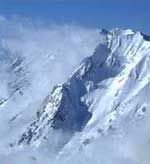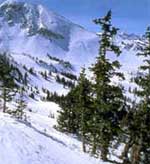| 1864 |
Silver is discovered in Alta during a picnic outing of soldiers from Fort Douglas. |
| 1865 |
First verified claim is staked in Alta. |
| 1868 |
The Emma mine becomes embroiled in controversy. British investors accuse principals of fraud after silver-bearing ore disappears in a fault. |
| 1870 |
Central City, the first community in the area, grows along Little Cottonwood Creek below the present Alta Lodge. Population 216. |
| 1871 |
A post office is established in Clasbey Read's General Store, the largest building in town. Alta townsite is established as a outgrowth of Central City. The townsite is located near the present Albion Lift. Ten streets ran east/west, 11 streets ran north/south. |
| 1872 |
The seasonal population of Alta grows to several thousand. There are 180 buildings, from two-story hotels to makeshift shanties. |
| 1873 |
Silver is devalued; mining activity begins to decline. For a short time, two newspapers are published, The Alta Independent and The Cottonwood Observer. |
| 1875 |
The railroad to Alta is completed. Mules pull the ore cars up; gravity takes them down the canyon, with a brave and strong breakman on board. |
| 1878 |
Alta City destroyed by fire on August 3, 1878. The town was never completely rebuilt. |
| 1885 |
In February, 1885, the buildings which comprised the town of Alta, were hit by an avalanche. Over 15 people lost their lives. As reported, the town's main street was covered by 50 feet of snow. |
| 1896 |
Utah becomes a state. |
| 1901-1910 |
Alta experiences a brief and modest mining resurgence. |
| 1904 |
Most individual mines are consolidated into one of three mining companies: Wasatch Mines, Alta United, and Michigan-Utah. Workers lived in company provided buildings, not in the old townsite. |
| 1917 |
The Denver and Rio-Grande railroad completes a narrow-gauge railroad to Alta, replacing the mule-drawn rail. |
| 1920s |
One of Alta's few remaining inhabitants, George Watson, appoints himself Mayor of Alta and runs the railway to and from Alta as a scenic attraction on a bus-like contraption called his "Jitney." With the depression, mining operations at Alta ceased, except for a few men, such as Watson, who continued to prospect on a limited basis. |
| 1935 |
Forest Service retains famous skier, Alf Engen, to hike into Alta and determine its potential for a future ski area site. Alf visits Alta twice and makes recommendation to go forward with plans to acquire additional land for the ski area. |
| 1936 |
A road to Alta is completed following the same path used by the railroad tracks in prior years. |
| 1937 |
"Mayor" George Watson deeds surface rights to 700 acres of land at Alta to the Forest Service in exchange for needed tax relief. Other Alta mining companies also assist which, when completed, amounted to approximately 1800 acres for development of Alta Ski Area.
Salt Lake attorney, Joe Quinney, along with several other prominent businessmen, form the Salt Lake City Winter Sports Association to oversee the development of the Alta ski area.
|
| 1938 |
Construction begins on Alta's first ski chairlift, Collins, which becomes the second one built in America. Material used in an old aerial tramway, which transported ore from down Little Cottonwood Canyon, formed the basis of the new ski lift. |
| 1939 |
Collins chairlift begins operation to the public on January 15th, charging 25 cents a ride or a full day pass for $1.50.
Also in 1939, Alta's first public shelter, currently known as the Snowpine Lodge, was constructed by the Works Progress Administration (WPA); and Sverre Engen was appointed by the Forest Service to become America's first Snow Ranger, stationed at Alta to perform snow studies and do avalanche control work.
|
| 1940 |
The Alta Lodge opens for overnight accommodation to destination skiers. |
| 1942 |
Training in winter warfare conducted at Alta by Company B of the 503rd Parachute Battalion, in preparation for overseas duty. |
| 1944 |
Utah's first promotional ski film, titled, Ski Aces, was completed at Alta by Twentieth Century Fox Studios. It starred the three Engen brothers, Alf, Sverre, and Corey; and highlighted the scenic beauty of Alta in winter conditions. |
| 1947 |
The Rustler Lodge opens. |
| 1948 |
The Peruvian Lodge opens. |
| 1954 |
The Germania Lift constructed as Alta's first double chair. |
| 1962 |
The Goldminers Daughter Lodge opens. The Albion double chairlift constructed. |
| 1965 |
The Engen family donates land for a by-pass road to be constructed to Alta to divert traffic from potential avalanche hazards under Mt. Superior during winter months. |
| 1967 |
The Sugarloaf double chairlift is constructed. |
| 1968 |
Alta re-establishes a post office after having gone without one since the 1920s. |
| 1970 |
The Sunnyside double chairlift is constructed. In addition, Alta incorporates as a town. |
| 1971 |
A sewer line is constructed up Little Cottonwood Canyon. |
| 1972 |
Bill Levitt becomes Alta's first elected President, along with four elected Board of Trustee members. (Titles were changed by the Utah legislature in 1977 to Mayor and Town Council). Alta established an emergency dispatch center and hires the first two resident police officers, Gene Huber and Tom Plofchan. |
| 1976 |
Alta Fire Department is founded with Toby Levitt appointed as the first Fire Marshal and Fire Chief. |
| 1978 |
Alta develops its first state-approved culinary water system, providing town water through the Bay City Mine tunnel. |
| 1978 |
Alta Fire Station is completed. |
| 1981 |
Cecret and Supreme double chairlifts completed. |
| 1991 |
Germania Lift is upgraded to become Alta's first triple chair. |
| 1992 |
Sugarloaf Lift is upgraded to a triple chair and a new design transfer tow is constructed between the Wildcat and Albion base areas. |
| 1994 |
New Alpenglow mid-mountain Lodge completed and opened to the public. In addition, Alta constructs a new community center/chapel and a town office building. |
| 1995 |
Chic Morton honored by University of Utah Marriott Library Ski Archives for Outstanding Achievements and Contributions to the Sport of Skiing. |



![]()





